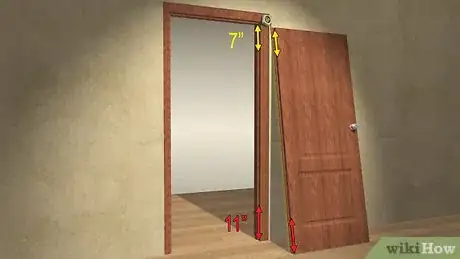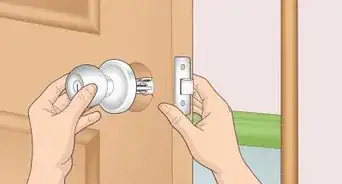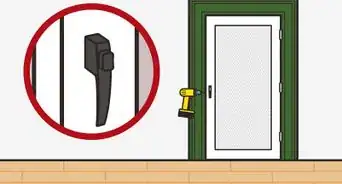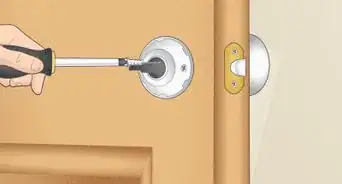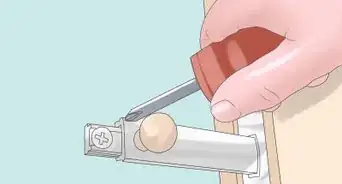This article was co-authored by Ryaan Tuttle. Ryaan Tuttle is a Home Improvement Specialist and the CEO of Best Handyman, Inc. in Boston, Massachusetts. With over 17 years of experience, he specializes in building home service businesses, focusing on creating scalable and efficient brands. With the help of his global team, the companies have achieved over 10+ million in sales and received recognition through magazine features, and enjoy partnerships with wikiHow and Jobber field service software. Boston Magazine and LocalBest.com have named Best Handyman Boston the Best Handyman in Boston. Ryaan holds Construction Supervisor and Home Improvement Contractor Licenses.
There are 11 references cited in this article, which can be found at the bottom of the page.
This article has been viewed 220,726 times.
A pocket door is the perfect solution for closing off an open section of your home or office or adding a quick way to move from room to room where a wall currently exists.[1] These doors disappear into the wall when opened, rather than taking up space in one room or the other. With the right tools and know-how, you can install pocket doors yourself, avoid the hassle of hiring a contractor, and take a hand in the design of your own home.
Steps
Making Space for Your Pocket Door
-
1Purchase a pocket door kit at a hardware store. This kit should contain the door, split studs that allow the door to retract into the wall, a track on which the door runs into the wall, and door hardware. Most are under $100.
- You may be able to find pocket doors at lumberyards, too. Regardless of where you go, you should easily find kits for doors that are 1 1/8 inches to 1 3/4 inches thick by 6 feet (1.8 m) 8 inches high. If your door is not a standard size, talk to a professional about getting the job done.
-
2Check the wall. The last thing you want to do is to tear a hole into your wall only to find that it's not feasible to put a door there. Before you go about drilling and tearing down, check for the following things:[2]
- Check if there's enough room in the wall. You need just over twice the width of the door (so it can hide).
- Check if the wall is load-bearing or just a partition. If it is load bearing, you'll need a new header and a means of temporary support while the door is being worked on.
- Check for wiring or plumbing. A wall with pipes in it is not a good place to put a door. Wiring can be easily detected with a cheap voltage sensor.
Advertisement -
3Remove the existing door, if applicable. If you're replacing a door with a pocket door, you'll need to get rid of the existing door. Start with removing the molding and, with a reciprocating saw blade, cut the shims. When the nails are cut, you can remove the door frame.[3]
- Door jambs aren't nailed against the studs in the wall – they're just spaced with wooden shims.
-
4Remove the drywall on one side of the wall. Do this slowly to make sure you haven't missed any obstacles within the wall.[4] Remove the drywall a few inches above where the header will be, but don't go all the way to the ceiling – that just means more work later.
-
5Cut the exposed studs carefully. This makes room for the new framing. You may find this step easier if you use a combination of a circular saw and a small hand saw; you do not want to accidentally damage the wall you did not cut away. The goal is to leave large enough holes in the studs to allow the pocket door to pass through.
- A standard pocket door is 1.75 inches (4.4 cm) wide. To make this step even easier, look for a pocket door kit that comes with split studs.
Assembling the Door and Hardware
-
1Make a new header, if necessary. It's possible that your door will require a header of a different height.[5] The height of your header is determined by whether or not you need a new soleplate. If the floor covering above the subfloor is minimal, the split-stud brackets can be secured directly to the floor. To determine the header height for most standard kits, figure the length of the new door, plus 3 1/4" and the height of the soleplate, if any. Once the appropriate length is determined, install a new stud this length from the existing stud on the opposing side. Nail the new header in place (or screw) and then cut and fit the soleplate to the floor.
- To adjust the header, use a reciprocating saw to remove the partition header currently in place. Then, cut away the studs, just like in the above, to make space for the framing.
- Cut the nails that are between the studs and the soleplate and then determine the height of your desired header before cutting the stud tops to length. Otherwise, you may end up with a frame that is not to size.
-
2Install the slider track. Your pocket door kit should contain the rails on which the door slides into the wall. Install the slider track using the directions that come with your pocket door kit, screwing the brackets into the studs. If you are also installing pre-split studs, you can install them after you install the slider track.[6]
- If you need to cut the track to length, use the mark on it that corresponds to your door size. Most, if not all, kits come with these markers. Use a hacksaw on the channel and a handsaw on the nailers.
- Make sure your track is level. If it's not, it won't slide easily in and out of its pocket.
-
3Place the hardware and the door into the slider track. Make sure that the door is sliding easily and stays level. Mount hangers on the top of the door – this is how the door will slide. Then, slide the wheeled carriages into the track. Hook the hangers onto the carriages. Once it's all set, adjust the assembly until the door hangs plumb and is in place.
Finishing the Project
-
1Replace the drywall you removed at the beginning of the project with new drywall. For this part, you'll need panel adhesive and screws. However, don't move onto taping and mudding just yet – there's still a bit more work to be done.[7]
-
2Install the latch hardware. The pocket door kit should have come with door latch hardware. Some of this will be attached to the door and some will be attached to the wall. Follow the instructions that came with the pocket door kit. Make sure the door is still sliding easily on the track and that the latches line up as needed.
-
3Finish installing the drywall. At this point, you can tape and mud the drywall. Apply plenty of drywall compound, aiming for multiple coats over every seam. Embed tape in it, then get rid of any excess compound. Allow it to dry, sand it, then apply the next layers of compound using the same method as necessary.
- When you are finished, sand the drywall to make it finished and smooth.
-
4Paint or otherwise decorate the wall as you see fit. The hard part is done – all you have to do now is return the wall to its original (or new and improved) state.
- Do this before you install the door trim, unless you want the door trim painted, too. This way if your lines aren't perfectly straight, the trim will cover them right up.
-
5Install the door trim. The trim hardware should have come in your pocket door kit. Install it according to the pocket door kit instructions. Nail or screw it to the jamb and the door studs.[8]
- That's it! Your pocket door is officially ready for use and looks like it was installed professionally.
Community Q&A
-
QuestionWhere does the door guide go?
 Community AnswerWhen the door is open, place door guides at the bottom of the frame. Pull the door out a little bit so you don't position guides too close to the door, leaving an eighth inch gap on both sides of the door to prevent rubbing or scarring of the finish.
Community AnswerWhen the door is open, place door guides at the bottom of the frame. Pull the door out a little bit so you don't position guides too close to the door, leaving an eighth inch gap on both sides of the door to prevent rubbing or scarring of the finish. -
QuestionAre there tracks both at the top and bottom of the pocket doors?
 Community AnswerThere are only tracks on the top of pocket doors, just like sliding closet doors. Sliding closet doors usually come with a small guide for the bottom that you screw to the floor where the two doors overlap. This keeps them from swinging in and out. Pocket doors sometimes have a similar U-shaped guide, or two wedges you screw down on either side of the door to keep it swinging into the doorjambs and ruining your paint job.
Community AnswerThere are only tracks on the top of pocket doors, just like sliding closet doors. Sliding closet doors usually come with a small guide for the bottom that you screw to the floor where the two doors overlap. This keeps them from swinging in and out. Pocket doors sometimes have a similar U-shaped guide, or two wedges you screw down on either side of the door to keep it swinging into the doorjambs and ruining your paint job. -
QuestionShould I wait until the ceramic floor is finished before installing the pocket door?
 Community AnswerYes.
Community AnswerYes.
Things You'll Need
- Pocket door kit
- Circular saw
- Handsaw
- Hacksaw
- Sander
- Additional tools as required by specifics of pocket door installation kit
References
- ↑ https://www.bobvila.com/articles/installing-a-pocket-door/
- ↑ https://www.popularmechanics.com/home/interior-projects/how-to/a1280/install-a-pocket-door/
- ↑ https://www.familyhandyman.com/doors/how-to-remove-a-door/
- ↑ https://www.bhg.com/home-improvement/walls/how-to-remove-drywall/
- ↑ https://www.familyhandyman.com/walls/how-to-build-window-headers-and-door-headers/
- ↑ https://www.dummies.com/home-garden/home-improvement/doors/how-to-install-pocket-doors/
- ↑ https://www.bhg.com/home-improvement/door/door-repair/how-to-install-a-pocket-door/
- ↑ https://www.familyhandyman.com/carpentry/trim-carpentry/interior-trim-work-basics/
- https://www.familyhandyman.com/carpentry/trim-carpentry/perfect-trim-on-doors-windows-and-base-moldings/
About This Article
To install a pocket door, start by removing the existing door and the drywall on one side of the wall. Then cut the exposed studs to make room for the new framing. Next, install the slider track using the rails that came in your pocket door kit. Be sure to screw the brackets into the studs! Then put the hardware and door into the slider track. Replace the drywall, but hold off on taping and mudding it until after you install the latch hardware. Once that's done, install the door trim that came in the kit. If you want to learn how to check your walls to see if you can install a pocket door, keep reading!


